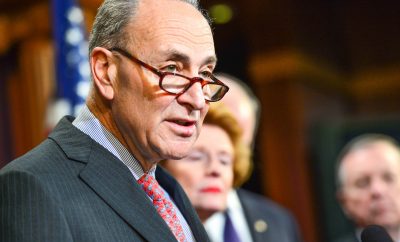 "Democratic Convention @ Invesco" courtesy of [rabidmoose via Flickr]
"Democratic Convention @ Invesco" courtesy of [rabidmoose via Flickr]
Elections
How do Superdelegates Work? And Why are People so Mad?
The saying, “The system is rigged” is one of Bernie Sanders’ favorite lines on the campaign trail. He gives speech after speech highlighting economic injustice and inequality that reiterates the same sentiment. It’s why so many of his supporters are passionate in their support for his campaign, but Sanders’ animosity towards the system may expand in the coming months to an additional target: the Democratic Party’s primary system.
When news broke that Bernie Sanders won the New Hampshire primary by more than 20 percent, yet may tie Hillary Clinton in delegates, Sanders supporters and Hillary-haters were irate. How could this be? What sort of system lets that happen? Welcome to the primaries, where everything’s made up and the points don’t matter. Okay, they matter a little bit, but it’s complicated. To understand the outrage after the New Hampshire primary, you need to look closer at the role of superdelegates.
So in this installment of “Why the Primaries are Weird,” we’ll be diving into everyone’s favorite subject: delegate math–specifically the Democratic Party and its superdelegates.
How do Delegates Work?
Before we get into the absurdity that is superdelegates, let’s do a quick review of how delegates come into play in the primary system. Each state elects delegates, individual party members who are pledged to a certain candidate based on the outcome of the state’s primary or caucus. The way delegates are chosen varies widely by state, but the important thing to know is that they are based on the outcome of a primary or caucus. Generally speaking, delegates are allocated proportionally based on their share of the vote in an individual state’s primary or caucus.
Delegates elected at the state level are then bound to a specific candidate, meaning that when the Democratic and Republican conventions occur after the primaries, elected delegates cast their votes for the candidate that they are pledged to. When all is said and done, the candidate with a majority of the delegates in the party convention wins the nomination and proceeds to the general election.
What about superdelegates?
The process outlined above is the way that Republicans choose their nominee and how the Democrats allocate most of their delegates, but not all. Enter superdelegates, a group of individuals chosen by the party who are allowed to vote in the Democratic Convention alongside the elected pledged delegates. The difference between superdelegates and regular delegates is their “unpledged” nature. Regular delegates are pledged to support a specific candidate based on the outcome of a state’s primary or caucus. Superdelegates are not pledged and are essentially free to vote however they wish at the Democratic Convention.
Superdelegates are Senators, Congressmen, and state party officials, and essentially exist to give the Democratic Party more control over their nominating process. While each party has additional delegates for “party leaders and elected officials” (PLEOs), all Republican PLEOs and most Democratic PLEOs are pledged, meaning that they are bound, at least in some way, to the results of state elections. The remaining unpledged PLEOs are the superdelegates.
To win the Democratic nomination, you need to have at least 50 percent of the 4,763 total delegates, making it a race to 2,382 delegates. Out of the 4,763 total delegates, 712 are unpledged superdelegates, approximately 15 percent. This means that a candidate could conceivably lose the popular vote and still win the nomination with the support of enough superdelegates. This is how Sanders was able to win the popular vote by a massive margin while possibly tying Clinton in the delegate count. Six of New Hampshire’s eight superdelegates support Clinton, so the race appears much more even. In fact, Clinton had a large national lead over Sanders before the race even started because of the number of superdelegates who say they will support herm though it is important to note that these superdelegates have up until the Democratic Convention to change their mind.
So… Blame Hillary?
No, you can’t blame Hillary Clinton. This is a perfect example of “don’t hate the player, hate the game.” You don’t have to like Hillary Clinton as a person or as a candidate, but she is not responsible for the Democratic Party’s undemocratic system of choosing its nominee. Sanders, a candidate who isn’t even really a Democrat, is inherently disadvantaged by the system, but that doesn’t make it Clinton’s fault.
I’m not defending Hillary Clinton, I’m just saying that if you are mad about the system, which is understandable, you should be mad at the Democratic Party. But before you claim that superdelegates are just another way that the Democratic Party is sidelining Bernie Sanders, you should remember that this system has been around since the 1980s and probably isn’t going away anytime soon. In a perfect bout of irony, to get rid of superdelegates, the superdelegates themselves would have to make the final decision.








Comments